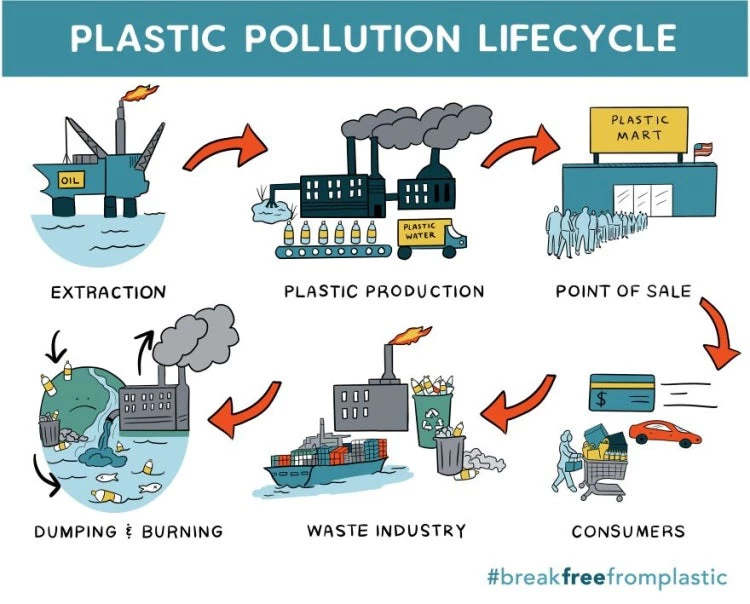 غالبًا ما تكون مساهمة النفايات البلاستيكية وصناعة البلاستيك في تغير المناخ أقل شهرة أو أسوأ، ويتم تجاهلها. الصورة: Shutterstock.com
غالبًا ما تكون مساهمة النفايات البلاستيكية وصناعة البلاستيك في تغير المناخ أقل شهرة أو أسوأ، ويتم تجاهلها. الصورة: Shutterstock.com
What is the link between plastics and hurricanes Sandy and Katrina in the United States, melting glaciers in Antarctica, summer heat waves and erosion of coastal areas in Australia, and other natural disasters hitting us with greater frequency? We blame climate change for that. However, the contribution of plastic waste and the plastics industry to climate change is often less known or worse, disregarded.
Plastic waste surrounds us – it is found in the air we breathe, in glacial ice on Mount Everest, in the water we drink, in fish we eat, and it was even recently discovered in human placenta. Plastics also have indirect negative impacts across its lifecycle, the consequences of which are neither visible nor obvious.
- Extraction and production: Most people do not realize that plastics originate from fossil fuels. In fact, the plastic industry accounts for about 6 percent of global oil consumption and is expected to reach 20 percent by 2050. As a result, due to the energy-intensive processes required to extract and distill oil, the production of plastics generates enormous amounts of greenhouse gas (GHG) emissions.
- Consumption: Most people think that when plastic is discarded in recycling bins, it goes away. But there is no “away” – only 9 percent is recycled globally and the rest is dumped in the natural environment. In fact, South Asia is one of the largest generators of plastic waste, discarding more than 26 million tons of plastics every day. South Asia also has among the world’s highest portion of waste that is openly dumped – 75 percent.
- End of life: When not recycled or disposed of in a controlled manner, discarded plastic waste generates GHG emissions when exposed to solar radiation both in air and water. Around 18 million tons of plastics originating from South Asia are mismanaged and, consequently, are washed into the ocean, where they emit methane and ethylene due to exposure to sunlight. Polyethylene is the highest emitter of both gasses and is the most produced and discarded synthetic polymer globally.
- Recycling and Closing the Loop: Even though recycling could significantly reduce the impact of plastic pollution on the environment and its contribution to climate change, only 5 percent of total waste generated in South Asia is recycled . The AIR (Avoid, Intercept, Redesign) circular economy principles applied to cement, aluminum, steel, and plastics could reduce the combined emissions of these industries by 40 percent.
- Marine litter: A garbage truck equivalent of plastic waste is dumped in the ocean every minute. It’s more than an eyesore. Marine plastic pollution breaks down into microplastics and contributes to climate change both through direct GHG emissions and indirectly by negatively affecting ocean organisms. Plankton sequesters 30-50 percent of carbon dioxide emissions from anthropogenic activities, but after it ingests microplastics, plankton’s ability to remove carbon dioxide from the atmosphere decreases.
- Open burning: Open burning is a common waste treatment practice in South Asia and around the developing world. The amount of waste burned in India and Nepal combined accounts for 8.4 percent of waste burned globally. Burning of waste in open fires leads to the production of a serious air pollutant, black carbon and is responsible for half of the visible smog in cities like New Delhi. The global warming potential of black carbon is up to 5,000 times greater than that of carbon dioxide (CO2).
The impacts of mismanaged plastic waste on the climate, as well as on livelihoods and ecosystems, are an urgent development challenge.
The impacts of mismanaged plastic waste on the climate, as well as on livelihoods and ecosystems, are an urgent development challenge. To solve this problem, targeted, innovative circular economy approaches are needed. A circular economy approach starts at the stage of product design and selection of raw materials with an aim to develop products that are optimized for reuse, creating ‘renewable resources’ and minimizing the need for both the final disposal of waste and mining of virgin materials.
The good news is that there are growing number of examples being implemented in South Asia. At all railway stations in India, tea will soon be served in perfectly biodegradable and environment-friendly earthen cups instead of plastic ones. Spider silk film and seaweed can replace plastic in various applications such as single-use sachets, which make up as much as 50 percent of all household plastic waste. In Maldives, an innovative collaboration between Parley for the Oceans and Adidas is bringing upcycled marine plastics into the global athletic wear supply chain. These sorts of innovations and partnerships show us that ground-breaking solutions for marine plastics and climate change exist and can be scaled up.




Join the Conversation